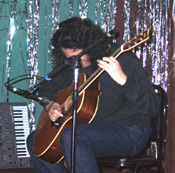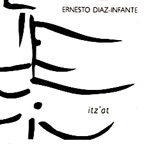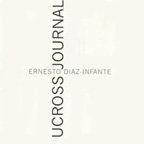| |
Ernesto
Diaz-Infante : In Concert & On Record
Houston TX, 18 November 2001
by Frank Rubolino
January 2002
 Ernesto
Diaz-Infante is a constantly evolving artist. He is an active member
of the thriving San Francisco experimental music scene, and he is
curator of the annual Big Sur Experimental Music Festival, which is
now in its third adventurous year of existence. Diaz-Infante is an
accomplished pianist and guitarist, but as he explores the potential
of his talent, he is ever changing, ever seeking, ever trying to find
the elusive holy grail that will satisfy his sonic wanderlust. Although
he has produced four striking solo piano albums for Pax Records, he
currently is concentrating most of his energy on the guitar—and
not just the guitar as a melodic string instrument, but the guitar
as a vehicle for developing absolutely undiluted sound. Diaz-Infante
cites Bhob Rainey, Greg Kelley, and their group Nmperign as significant
forces in shaping his musical direction, and that direction is on
the cutting edge of acoustic experimental sound/noise. Ernesto
Diaz-Infante is a constantly evolving artist. He is an active member
of the thriving San Francisco experimental music scene, and he is
curator of the annual Big Sur Experimental Music Festival, which is
now in its third adventurous year of existence. Diaz-Infante is an
accomplished pianist and guitarist, but as he explores the potential
of his talent, he is ever changing, ever seeking, ever trying to find
the elusive holy grail that will satisfy his sonic wanderlust. Although
he has produced four striking solo piano albums for Pax Records, he
currently is concentrating most of his energy on the guitar—and
not just the guitar as a melodic string instrument, but the guitar
as a vehicle for developing absolutely undiluted sound. Diaz-Infante
cites Bhob Rainey, Greg Kelley, and their group Nmperign as significant
forces in shaping his musical direction, and that direction is on
the cutting edge of acoustic experimental sound/noise.
He
told me when we spoke recently in Houston that he is seeking total
sound purity, the ultimate source of sound in its most natural configuration.
The occasion was a concert he was giving with local Houston guitar
innovator Philip Gayle. Using an accumulation of string instruments
from small violins to larger guitars, the two artists began by turning
them into percussion tools. They smacked the strings and rubbed,
slapped, and thumped the wooden bodies to hear for themselves what
sound would result. Then, to the surprise of the audience, Diaz-Infante
became more physical. He plunged a drumstick into the back of his
guitar and proceeded to twist and turn it to produce a symphony from
the crackling wood. Gayle took the cue, and he also began systematically
decomposing his instruments. The microphones picked up every nuance
of shattering wood, bent strings, and broken tuning screws. As the
instruments began to disassemble before one’s eyes, the two would
play the hanging, limping strings to eke out whatever sound was left
in the disembodied structure. They were joined midway through the
performance by voice master Ben Lind and viola player Dr. Rose Lange.
With
the grunts, whistles, groans, and falsettos of Lind on one side and
the sparse and eerie string playing of Lange on the other, Diaz-Infante
and Gayle accumulated a pile of rubble that once saw life as string
instruments. At the end, nothing was left but the pieces and fragments
on which the two could pound plus the echo of the life that oozed
from them. Diaz-Infante used a remaining guitar neck to sweep the
debris into a central pile while simultaneously creating compatible
acoustical noise. Although the instrument attack was not violent,
it was startling to view and just as amazing to hear. Diaz-Infante
may well be on his way to reaching his sonic quest.
The piano music of Ernesto Diaz-Infante is a totally different matter
and evolves as a thought-induced process devoid of such physicality.
It is pensive, introspective, and near-meditative, building on somber
tones that dwell in dark recesses of his mind; yet the captive poetry
is able to escape its habitat and in so doing expose his searching
soul. These four albums span a period of 28 months. Itz’at
and Tepeu were recorded on the same date in 1997, Ucross
Journal 14 months later, and Solus 14 months after that.
Each is a solo venture where Diaz-Infante probes deeply into the inner
core of the songs. His musings are reflective, spontaneous, sometimes
sparse, and sometimes voluminous. They surface as gems of beauty dripping
from the vibrating keys.
 Itz’at consists of a suite in 13 parts plus one additional
in-depth analysis. It is marked by sound and space, with both of these
natural elements having an equal footing. Diaz-Infante builds short
phrases of interrupted but not abrupt lines, and then works around
and through them to milk every nuance of potential from them. His
touch is semi-percussive, his tone highly resonant, and his methodology
patient and exploratory. With each succeeding phrase of the suite,
he dissects the lines with the precision of a surgeon and reduces
them to their lowest common denominator. His direction appears linear,
using the short fragments of contemplative notes to ponder the seriousness
of life in layered fashion. “Mariposa Liviana”, which follows
the suite, develops in full-bodied measures by expanding the resonance,
filling in the space, and uniting in a substantive statement having
the same weighty countenance as the suite. The recording is a telling
look into the mind of the man. It leaves one pondering the mysterious
path he took while being uplifted by the journey.
Itz’at consists of a suite in 13 parts plus one additional
in-depth analysis. It is marked by sound and space, with both of these
natural elements having an equal footing. Diaz-Infante builds short
phrases of interrupted but not abrupt lines, and then works around
and through them to milk every nuance of potential from them. His
touch is semi-percussive, his tone highly resonant, and his methodology
patient and exploratory. With each succeeding phrase of the suite,
he dissects the lines with the precision of a surgeon and reduces
them to their lowest common denominator. His direction appears linear,
using the short fragments of contemplative notes to ponder the seriousness
of life in layered fashion. “Mariposa Liviana”, which follows
the suite, develops in full-bodied measures by expanding the resonance,
filling in the space, and uniting in a substantive statement having
the same weighty countenance as the suite. The recording is a telling
look into the mind of the man. It leaves one pondering the mysterious
path he took while being uplifted by the journey.
Tepeu from the same session has six compositions, including
the lengthy title cut that depicts a Mayan god, whom Diaz-Infante
states brings order out of chaos just as his creative process does.
Other than the structured improvisation of this song, the pieces are
all instantly composed. Diaz-Infante continues his examination of
improvised sound while building the resonance and establishing a higher
level of flow by filling in all the cracks and crevices. The music
has a ringing continuum. Notes hang in the air while new expressions
vie to take their place and others cascade down as gently falling
rain. His touch also becomes more percussive as he induces the keys
to speak in more volatile tongues. Diaz-Infante opens the throttle
on “Antithesis” to establish a new foothold marked with
vibrant tonality and rushing waves of sound, only to retrench into
sacred ground on the ensuing “Synthesis” with its cognitive
deliberativeness. He is a seeker of sonic refinement and order on
this disc and continues to find the right path.
 By the time Ucross Journal was recorded in 1998, Diaz-Infante
had encountered a metamorphic experience through his residency at
the Ucross Foundation in Wyoming. The serenity of the surroundings,
the ambiance of nature and the environment, and the sheer majesty
of the landscape greatly influenced his approach to piano improvisation
at this time. The program contains 30, obviously short statements
on serenity, but they really flow together into a continuous collage
of color reflecting his emotional attitude from the exposure. One
can sense the openness of the land through the scattered density of
his conceptions where he again uses sonic space and introspection
to convey the hugeness of the Big Sky country. There is severe austerity
to his conceptualizing, marking it as a significant departure from
the robust style exhibited on Tepeu. Resonance, a strong sense
of dynamics, and reverberant chord structure still prevail as Diaz-Infante
exhibits yet another facet of his complex musical mind.
By the time Ucross Journal was recorded in 1998, Diaz-Infante
had encountered a metamorphic experience through his residency at
the Ucross Foundation in Wyoming. The serenity of the surroundings,
the ambiance of nature and the environment, and the sheer majesty
of the landscape greatly influenced his approach to piano improvisation
at this time. The program contains 30, obviously short statements
on serenity, but they really flow together into a continuous collage
of color reflecting his emotional attitude from the exposure. One
can sense the openness of the land through the scattered density of
his conceptions where he again uses sonic space and introspection
to convey the hugeness of the Big Sky country. There is severe austerity
to his conceptualizing, marking it as a significant departure from
the robust style exhibited on Tepeu. Resonance, a strong sense
of dynamics, and reverberant chord structure still prevail as Diaz-Infante
exhibits yet another facet of his complex musical mind.
Solus from 1999 finds Diaz-Infante again expressing himself
in energized terms with logically developed free improvisations spun
around a near-aggressive dynamic. His left hand and right hand compete
with opposing views on openness, allowing the music to advance to
a fully liberated state. He almost completely abandons the concept
of space as a partner to sound and fills the recording with ringing,
astutely creative improvisations. Diaz-Infante maintains his penchant
for resonance, and in these selections, the music resounds through
his vibrating authority. Gone for the most part are the spacious ruminations.
In their place are cascading swells of improvised music being swept
up in the current of activity he generates. Although he again employs
the suite concept, the 13 passages knit together to form an ongoing,
breathing example of free speech. In response to my inquiry on the
evolving nature of the four albums, Diaz-Infante told me that he felt
Solus was the culmination of what he was trying to say through
the piano.
Diaz-Infante is an intricate artist whose music projects the complexity
of the man and the emotions of his inner being. He is able to convey
his immediate feelings through his playing, making each recording
unique and rewarding. These four discs represent a composite of an
artist who uses his talent to express more than music—he expresses
himself.
|
|
|
|
|

